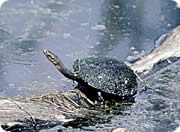Eastern Snake-Necked Turtle

Common Name: Eastern Snake-Necked Turtle
Scientific Name: Chelodina longicollis
Description
The Eastern Snake-necked Turtle lives in freshwater environments and feeds on aquatic invertebrates, tadpoles and small fishes. Most of its time is spent in the water, but it can make overland movements in search of new waterholes and nesting areas.
As its name suggests, this turtle has a long neck, which is usually about half the length of its carapace (shell). It has webbed feet used for swimming and digging. The colour of the carapace varies through shades of brown. Also known by another common name of 'stinker', this turtle can eject pungent liquid gland secretions from its 'armpits' and groin when handled or disturbed.
In summer, females dig holes in sand or in soft sediments along stream banks and lay about 10 eggs. These eggs occasionally provide a meal for Water-rats and lizards. Hatchlings are eaten by fish and birds, and adults may be killed by cars while moving overland.
The terms turtle and tortoise are often used interchangeably and can cause some confusion. In the past, all freshwater turtles were called tortoises and marine turtles were called turtles. The more recent convention has been to restrict the term 'tortoise' to the purely land-dwelling species. As such, Australia has no tortoises.
Size
Carapace up to 26 cm
Diet
They eat a variety of aquatic creatures, including tadpoles, small fish, crustaceans and molluscs. The shell length of adults is about 25cm.
Habitat
Freshwater, wetlands
Breeding
Breeding occurs in summer, when the females deposit up to 10 eggs in a hole they've dug in the stream bank or swamp.
Location or Region Found
Queensland, New South Wales, Victoria, south-eastern South Australia.
 Deep Sea Crabs
Deep Sea Crabs